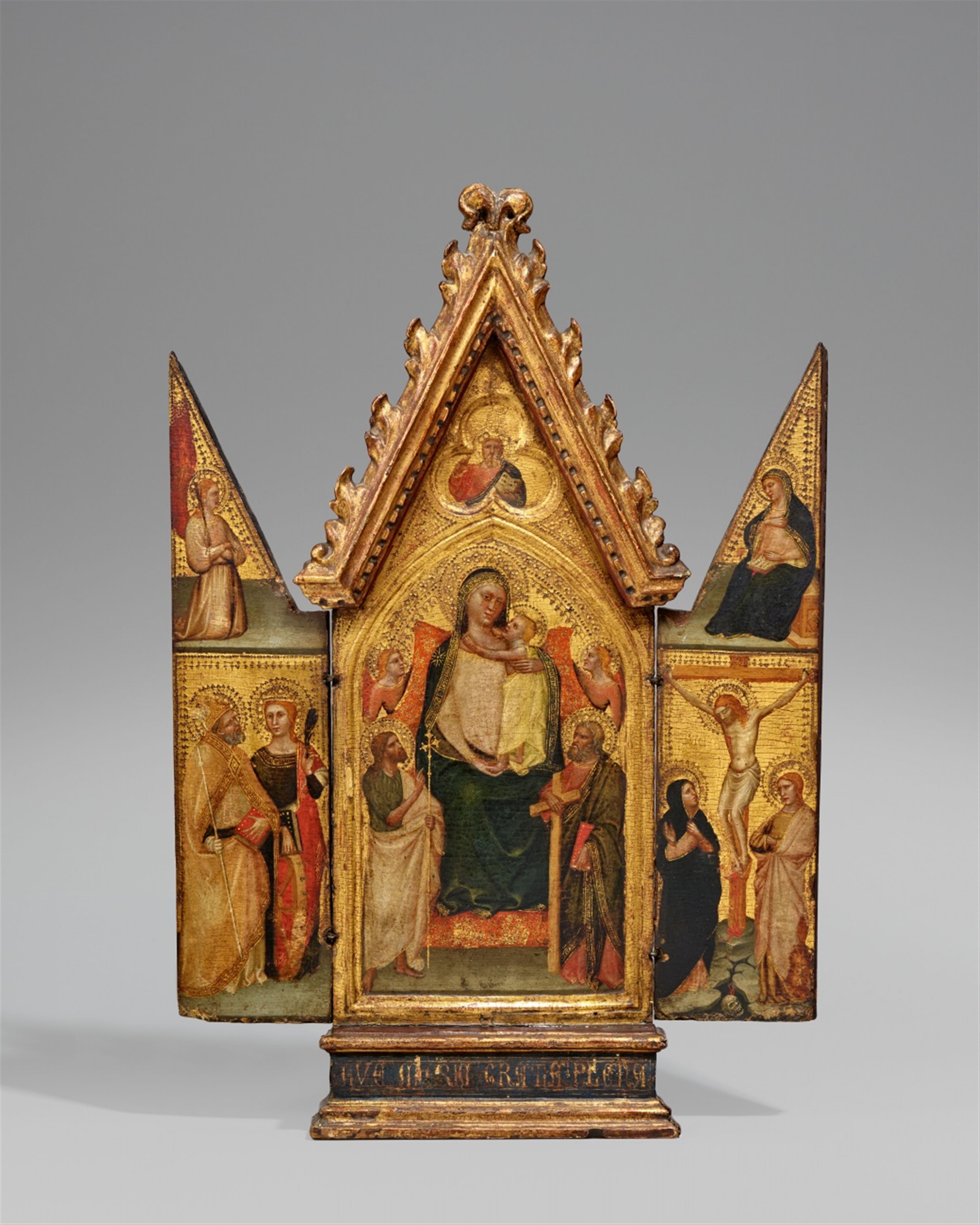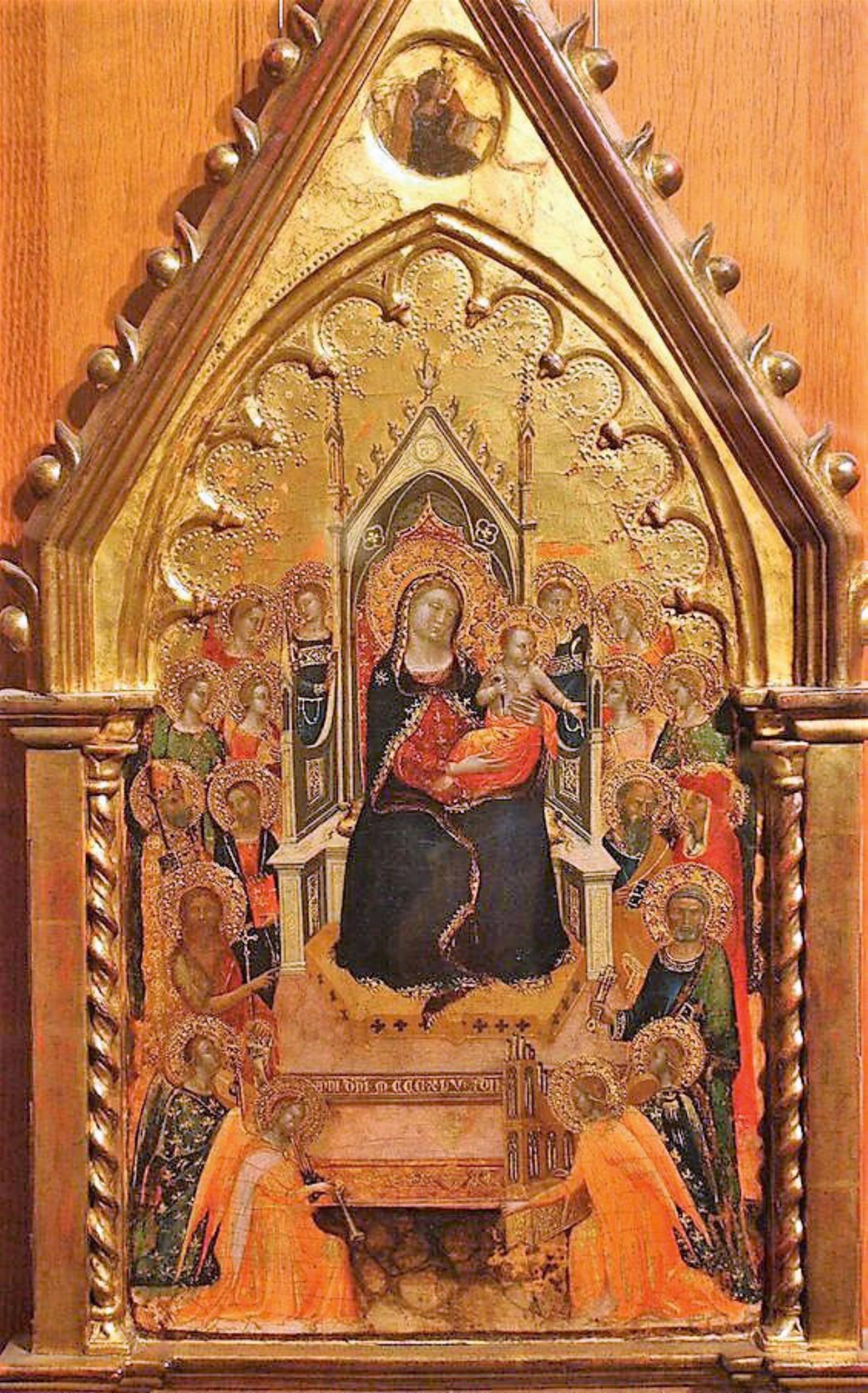Master of Tobia (Maestro di Tobia)
Triptych of the Madonna Enthroned
Tempera on panel. 46.5 x 28 cm (central panel) 46.5 x 11 cm (side panels).
The central panel of this small triptych depicts a brightly lit scene of the Virgin and Child enthroned. Despite the hieratic nature of their pose, the work evokes a sense of tenderness between the Mother and Child. Two angels, John the Baptist, and the Apostle Andrew bear witness to this heavenly spectacle. The two outer panels depict a Bishop Saint with Saint Catherine of Alexandria, the Crucifixion with the mourning Virgin and Saint John, and the Annunciation to the upper points.
This Florentine altarpiece is a fascinating rediscovery that conceals a complex art historical puzzle. The altar was apparently once owned by the Pie Donne della Carità di San Vincenzo de' Paoli in San Girolamo in Siena (Boskovits 1975, op. cit., p. 72-73). The question of how it came into their possession remains unanswered, and certainly does not automatically indicate that the work originates in Siena. The Gesuati abbey of San Girolamo was founded in 1354 and first came into the hands of the Pie Donne della Carità di San Vincenzo de' Paoli in 1855. The triptych may have been brought to the abbey by one of the nuns for private devotion. It was later sold on the English art market in the 19th century and was first documented in the estate of Julius Böhler in Munich in 1968, from whence it passed into a German private collection.
The art historical significance of this sumptuous Florentine triptych was first remarked upon by Adolfo Venturi (1856-1941), who brought it into connection with Giovanni da Milano in a letter to the previous owner. Miklos Boskovits later commented at length on the work's exceptional artistic quality in his magnum opus on Florentine painting in the latter 14th century, published in 1975.
One point of reference for the historical evaluation of this work is offered by a small panel depicting the Virgin enthroned, housed in the state collections of Budapest, which is dated to 1345 (fig. 1). This work clearly references earlier works painted by Bernardo Daddi and his circle, such as the altarpiece in the Lindenau Museum in Altenburg, dated just a few years before it. The work in Budapest displays undeniable stylistic similarities to the present triptych, and could actually originate from the same painter, although one decade earlier in his artistic development.
We recognise parallels in the figural models: The Virgin's similarly shaped round and softly modelled face appears in a comparable form in both works. The faces of the angels are also similar, and the figure of Saint Catherine on the left panel of the present work is highly comparable to the angel peering over the left side of the Virgin's throne in the Budapest work.
Now that it has been established that this altarpiece and that in Budapest originate from the same workshop, we may once again raise the question of this work's authorship, which is still discussed controversially to this day. The panel was once ascribed to Jacopo del Casentino, but in 2008 Alberto Lenza (p. 162-163) tentatively acknowledged Miklos Boskovits' (Boskovits 1994) previous attribution to an artist from the circle of Giusto de´ Menabuois. This Florentine artist was active in the circle of Stefano Fiorentino in Lombardy and later pursued a brilliant career in Northern Italy. However, Luciano Bellosi later rejected this attribution in 2001 (p. 40, note 57).
Thus far, only typological parallels have been drawn between Giusto de´ Menabuoi´s later works and the altarpiece in Budapest dated 1345. However, clear stylistic relations to the style of Florentine artists such as Stefano Fiorentino and Giottino indicate a common artistic origin. Similar allusions are also evident in the present panel, which shows that this regional style must also have been an important influence for its author. The Budapest altarpiece is dated 1345, and is thus thought to be an early example of this artist's œuvre, made at a time when he was still strongly influenced by the work of Bernardo Daddi and Stefano Fiorentino, and to a lesser extent by Maso di Banco. The present work not only displays these influences but also those of the circle of Nardo and of Andrea di Cione.
In comparison to those of the altarpiece in Budapest, the figures in this work display a larger physical presence, owing not only to their increasingly statuesque appearance but also to their more balanced arrangement within the piece, which is influenced by Giotto's compositional style. This is coupled with an increased tenderness of feeling, achieved through the finely nuanced shading inspired by Giottino and Stefano Fiorentino. The overall effect is one of increased sophistication, markedly different from the harder modelling and relief shading apparent in the works of the closely related masters Nardo di Cione and Andrea Orcagna. The similarities and the differences to the circle of the Cione brothers become obvious when we compare the crucifixion scene in this work to an otherwise exemplary example of this motif painted by Nardo di Cione, which can be dated to around 1350 and is now housed in the Uffizi. Despite the powerful modelling, the depiction of emotionality in the mourning figures beneath the cross remains somewhat superficial due to Nardo di Cione's harsher shading and outlining techniques. In contrast, the brighter tonality utilised by the author of the present triptych accentuates the individual features more clearly and thus conveys emotions with greater depth.
These observations lead us to believe that the artist responsible for this work was finely in tune to the stylistic undercurrents of the Florentine art world around 1350, and was able to combine the influences arising from the circle of Stefano Fiorentino and Giottino with the successful recipe established by the leading painters' workshop of the Orcagna brothers. It is perhaps no coincidence that his hand has been recognised in a monumental crucifixion fresco in the refectory of Santo Spirito that was later completed by Andrea Orcagna himself, who added the (now only fragmentarily preserved) depiction of the last supper. The artistic quality of this expansive crucifixion fresco (now also in fragmentary condition) once led Gert Kreytenberg to optimistically suggest an ascription to the workshop of Ambrogio Lorenzetti from Siena, and thus an earlier date of around 1330 (Kreytenberg 2000, p. 151-158). It is now assumed that the exceptionally talented painter responsible for the fresco is identical with the author of this triptych.
The artist in question, Andrea Orcagna's anonymous collaborator in the fresco project at Santo Spirito, has recently (Palmieri 2005, op. cit., p. 405-415) been brought into connection with the Florentine painter known under the notname “Master of Tobias”. This painter's œuvre has also been enriched by a significant number of works once attributed to the “Maestro del Bargello”, named after a fresco in the palace of the same name (Boskovits 1975, p. 355-357).
Throughout the 1350s, our painter must have orientated himself ever further towards the works of the Orcangna brothers, presumably inspired by his cooperation with Andrea Orcagna in the frescoes of Santo Spirito. This winged altarpiece is thought to have been made at a similar time to the frescoes. There is also evidence of his collaboration with Orcagna and his increased interest in Orcagna's style in another triptych in the former Beretta collection in Spello, which is thought to have been painted around 1360/65.
In summary, it can be said that this triptych is one of the finest works to be produced by this remarkable artist. This newest entry to the Master of Tobias' œuvre exemplifies a particularly creative time in trecento Florence. It is among the most beautiful small-scale polyptychs of the mid 14th century. In parallel to the work of the Orcagna brothers, the piece is a highly fine and original example of how the legacies of Bernardo Daddi, Maso di Banco, and Stefano Fiorentino were continued.
We would like to thank Professor Gaudenz Freuler for this catalogue entry.
Proceeds from the sale of this lot will go to benefit the Cardinal Meisner Foundation, Cologne, which helps church congregations in the Archbishopric of Cologne as well as countries in Central, Eastern, and Southern Europe.
Certificate
Gaudenz Freuler, March 2018.
Provenance
1872, Siena Monastero di San Girolamo. - 1968 - 1973 Julius Böhler, Munich. - The Helmuth Domizlaff Collection (1902–1983), Munich. – By descent to Hildegard Domizlaff (1898-1987), Cologne.
Proceeds from the sale of this lot will go to benefit the Cardinal Meisner Foundation, Cologne.
Literature
Miklós Boskovits: Pittura fiorentina alla vigilia del Rinascimento 1370 -1400. Florence 1975, p. 72-73 & 281, illus. 81.
Cited literature: M. Boskovits: Budapest Museum of Fine Arts, Esztergom Christian Museum. Early Italian Panel Paintings, Budapest 1966, p. 10-11. - M. Boskovits: Su Giusto de´Menabuoi e sul "giottismo" nell´Italia settentrionale, in: Studi di Storia dell ´Arte in Onore di Mina Gregori, Mailand 1994, p. 26-34. - Gert Kreytenberg: Orcagna. Andra di Cione. Ein universeller Künstler der Gotik in Florenz, Mainz 2000, p. 151-158. - L. Bellosi: Giottino e la pittura di filiazione giottesca intorno alla metà del Trecento, in: Prospettiva 1001, 2001, p. 40, note 57. - M. Palmieri: Profilo di un pittore fiorentino della metà del Trecento: Il Maestro di Tobia, in: Arte Cristiana XCIII, 2005, p. 405-415. - A. Lenza: Giusto de´Menabuoi, in: Giovanni da Milano, Capolavori del Gotico fra Lombardia e Toscana, Ausstellungskatalog Florenz, Galleria dell´ Accademia 2008, p. 162-163, cat. no. 7. - A. Tartuferi: Della tradizione gotica al primo Rinascimento, Florenz 2009, S. 20-29.




